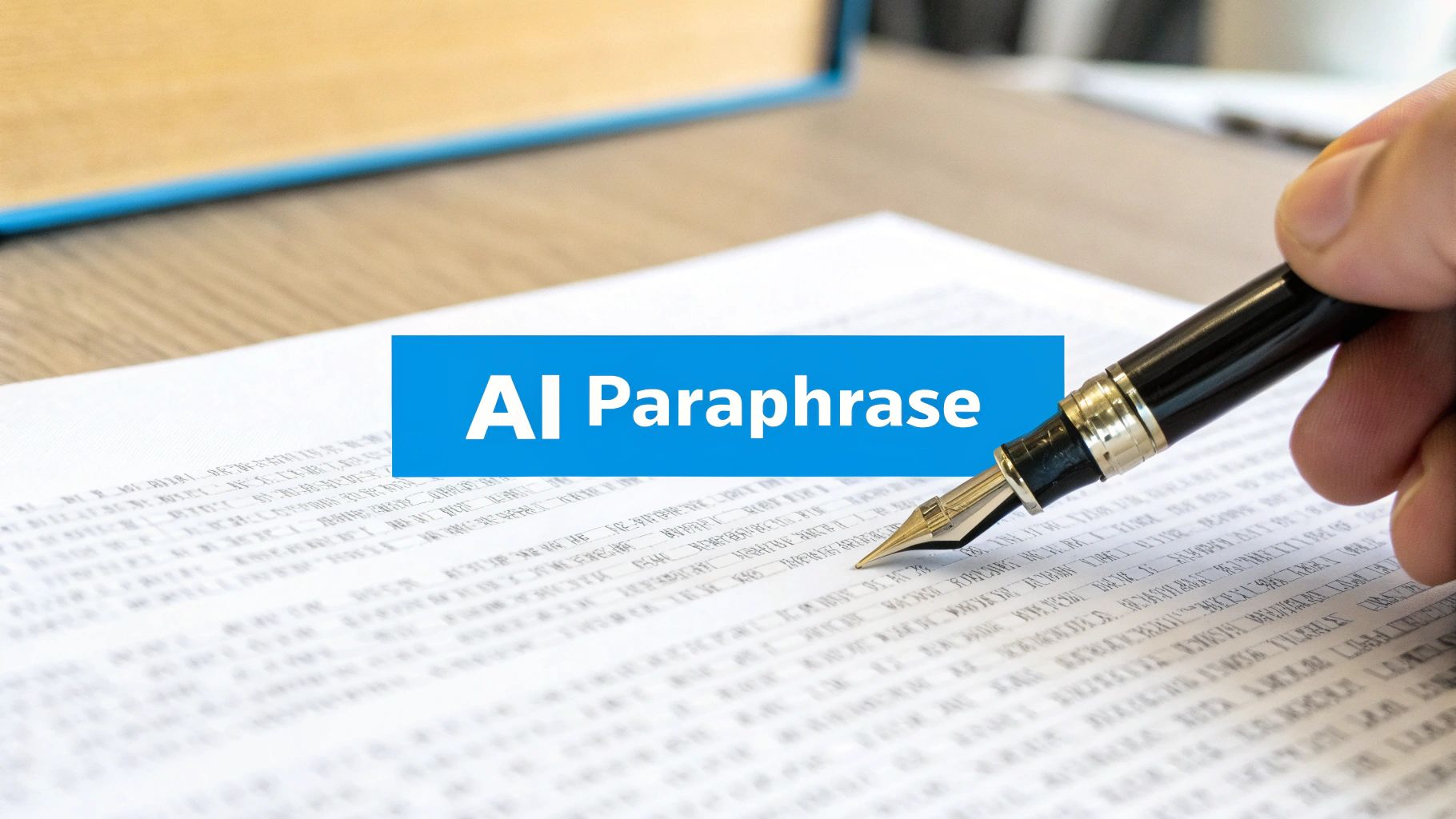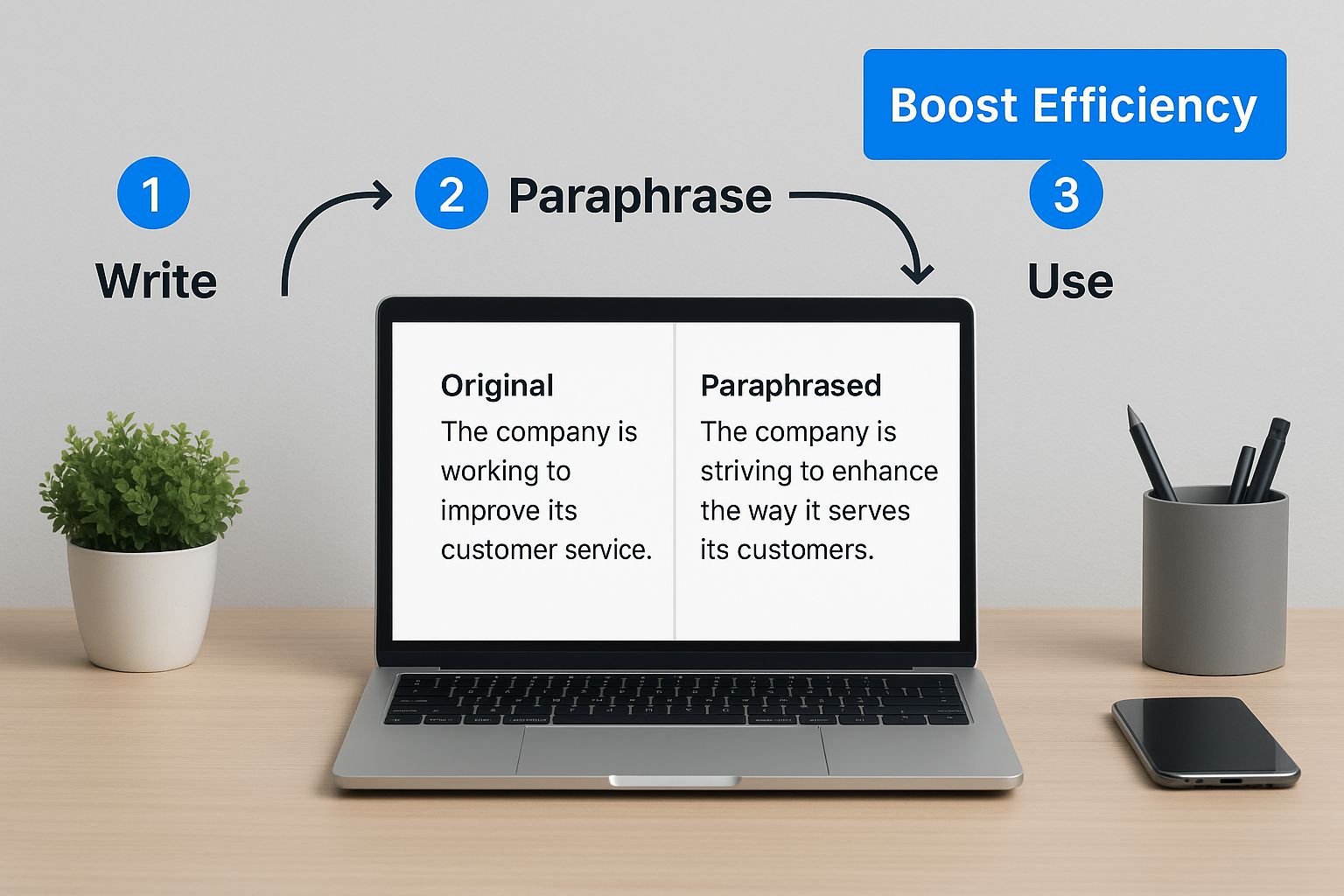What Is a Paraphraser AI Tool and How Does It Work

A writing tool that uses artificial intelligence is like a smart assistant for your words. It helps you rephrase sentences or whole articles while keeping the original point. Think of it as a creative helper that gives you new ways to say things, making your writing clearer, more interesting, and just right for your audience.
What Is a Paraphraser AI Tool
Imagine you're trying to explain something tricky to a friend. You say it one way, but they still look puzzled. So, you try again using different words and a simpler structure until they get it. A paraphraser ai tool does the same thing, but for your writing.
It's much more than a simple thesaurus that just swaps out words. Instead, it looks at the context, sentence structure, and original meaning of your text to come up with fresh alternatives that sound right.
This kind of tool is made to fix common writing problems. Whether you're a student trying to avoid plagiarism, a marketer making different versions of an ad, or a professional polishing an important email, these tools are a big help. They act like a good translator, not just changing words but keeping the real feeling behind them.
Going Beyond Basic Word Swapping
It’s a common mistake to think these tools just find synonyms. While that's a small part of it, modern paraphrasers are much smarter.
They can:
- Restructure Sentences: They might change a passive sentence to an active one or break a long, complicated sentence into shorter, clearer ones.
- Adjust the Tone: Need to make a casual draft sound more formal and professional? A good tool can change the tone to fit any situation, from an academic paper to a friendly social media post.
- Improve Clarity and Flow: By offering different ways to say something, a paraphraser ai tool helps you find the best way to get your message across and fix any awkward sentences.
A Partner in the Writing Process
In the end, these tools aren't meant to do your thinking for you—they're there to help. They can be a real help when you have writer's block, giving you the push you need to get your ideas flowing again.
By showing you different ways to say the same thing, they can even help you grow your vocabulary and become a more flexible writer over time.
For example, a high-quality tool like Word Spinner is excellent at creating text that sounds completely natural. Its powerful rewriting capabilities, ability to remove traces of machine writing, and guarantee of plagiarism-free content make it a top choice for anyone needing polished, human-sounding text for school or work. This method helps you keep your own voice while making your writing stronger.
How These Writing Assistants Actually Work
At first, a paraphrasing tool seems like magic. You put in some text, click a button, and out comes a perfectly rephrased version. But what's happening behind the curtain isn't magic at all—it's a clever process based on something called Natural Language Processing (NLP).
Think of NLP as the bridge that lets computers understand and use our language. It’s not just about changing words. NLP gives the software the power to understand grammar, context, idioms, and the small connections between ideas. This is the engine that runs any good paraphrasing tool.
When you give text to a paraphraser, it doesn't just look for synonyms. Instead, it takes your text on a quick but detailed journey to rebuild it from scratch, making sure the new version says the same thing in a totally new way.
Deconstructing and Rebuilding Language
The first thing the software does is take your sentence apart. It breaks it down into its main parts—nouns, verbs, adjectives, and phrases. This helps the machine make a grammatical map of your sentence to understand how every word works together.
Once it has that map, the tool uses its huge library of information. This is where it gets really smart. The tool looks at the relationships between words and ideas it has learned from countless books, articles, and websites. It knows, for example, that "increase sales" is closely related to "boost revenue" or "grow profits."
This ability to understand context is what makes a modern paraphraser different from a simple word-swapper. It considers the whole idea, not just single words, to produce a result that sounds natural and makes sense.
With this deep understanding, the tool starts to rebuild. It tries out different sentence structures and word choices to create new versions of your original text. This might mean making a simple sentence more complex, changing the order of clauses, or picking words that better fit a certain tone.
The infographic below gives a great picture of how these tools can make the writing process easier, taking an original piece of text and quickly turning it into a polished alternative.
This process is a big reason why these tools have become so popular, saving writers a lot of time and effort.
The Role of Context and Nuance
What truly makes rephrased text sound human is the tool's skill in handling context and nuance. The same word can mean very different things depending on how it's used. Think about the word "run"—it has a completely different meaning in "I will run a marathon" versus "I will run a company."
Good paraphrasers are taught to notice these small differences. They look at the whole piece of text to make smart word choices that keep your original meaning. This is why the best tools can rephrase tricky or technical content without making it sound strange or incorrect.
The need for this level of skill is growing quickly. The market for these tools was valued at around USD 1.2 billion in 2023 and is expected to grow much larger by 2032. That growth is all about the need for software that can truly understand and rewrite content like a person would.
For most people, the main goal is to make sure the final text doesn't sound like it was made by a machine. This involves more than just changing words; it's about adjusting sentence length, rhythm, and flow. If you're curious about this, our guide on how to make AI content undetectable goes deeper into the methods.
The different versions the tool gives you are the final result of this whole language workout. Your job is just to pick the one that works best, turning the paraphraser into a helpful writing partner instead of just a simple replacement tool.
The Main Benefits of Using a Paraphrasing Tool
Sure, paraphrasing tools save time, but the real advantages go much deeper. They’re more than just a word-swapper; they’re a helpful writing assistant that helps you improve the clarity, originality, and overall quality of your work.
One of the biggest wins? Getting past writer's block. We’ve all been there—staring at a sentence that just doesn't sound right or trying to find a new take on an old idea. A paraphraser instantly gives you different ways to say the same thing, sparking new thoughts and getting you back into your writing rhythm.
Having those options in front of you offers a fresh point of view, making it so much easier to polish your message until it’s just right.
Achieving Originality and Avoiding Plagiarism
For students and professionals, this is a big deal. A good paraphrasing tool can rewrite content so completely that it helps you avoid accidental plagiarism. That’s very important when you’re using source materials for research papers, articles, or client reports.
By rephrasing borrowed ideas in your own voice, you maintain your academic and professional honesty. The tool doesn't just move a few words around; it actually restructures sentences and uses different words to make the text truly yours.
But let’s be clear: these tools are a help, not a replacement for understanding the material. The goal is to express your own understanding of a topic, not just to pass off someone else’s work as your own.
This need for originality is a big reason the market for these tools is set to reach about $500 million in 2025. It's expected to keep growing at 25% each year through 2033, showing just how much need there is for original, high-quality content.
A Personal Writing Coach
Think of a paraphraser ai tool as your own personal writing coach, right there on your computer. Using one regularly is a great way to improve your skills. When you see different ways to frame your thoughts, you naturally start to use those methods in your own writing.
- Vocabulary Expansion: It will show you synonyms and words you might not have thought of, helping you build a richer vocabulary over time.
- Sentence Structure Variety: The tool shows you how to stop using the same sentence patterns over and over, making your writing much more lively and interesting.
- Tone Adjustment: Need to make an email sound more formal? Or make a blog post feel more casual? A paraphraser can quickly change your text to fit the right mood.
This coaching part alone makes it a great resource for anyone who wants to write with more confidence and skill.
Humanizing Your Content
In a world full of machine-written text, making your content sound genuinely human is more important than ever. The best paraphrasers are made to produce text that flows naturally, without the stiff, robotic tone that often gives away machine writing.
For instance, a platform like Word Spinner is built specifically to rewrite text in a way that avoids machine detection, guaranteeing the output is plagiarism-free and sounds like a person wrote it. If you’ve ever wondered why your text gets flagged, you should check out our guide on why text is detected as AI and how to fix it.
To get a sense of the wider effect of this tool, it's interesting to see how it's used elsewhere. For example, looking at the 7 Incredible Benefits of AI in Finance shows just how useful these systems are across completely different industries.
Who Should Use an AI Paraphraser
You might think a writing assistant is just for professional authors, but a paraphraser ai tool has a surprisingly large number of users. Its uses cover all sorts of fields, helping different people reach very different goals.
From students trying to understand dense school texts to business professionals polishing a key email, these tools are quickly becoming a favorite resource. It’s not about replacing the writer—it's about giving them a smart partner to improve their work, get past writer's block, and deliver a stronger final piece.
Students and Academic Researchers
For anyone in school, the pressure to produce original, well-written work is always there. A good paraphrasing tool can be a huge help.
When you're dealing with complex source material, you can use it to rephrase confusing parts into simpler language. This is a big help for just understanding the main ideas before you even think about putting them in an essay or research paper. Even more importantly, it helps you avoid accidental plagiarism by showing you how to express an idea in a completely new way.
- Essay Writing: A student can put a paragraph from a scholarly journal into the tool to see different ways of explaining the findings, making it much easier to summarize in their own words.
- Research Papers: Researchers can rephrase their own previously published work for new articles without having self-plagiarism issues.
- Understanding Feedback: If a professor's comment on an assignment is a bit unclear, a student could even rephrase the feedback to get a better idea of what needs to be fixed.
Content Creators and Marketers
In the fast world of digital marketing, content is key, and the need for new material never stops. Content creators, bloggers, and marketers are always looking for ways to work smarter without lowering quality.
A paraphrasing tool lets them quickly reuse existing content. That old blog post can be updated for a new audience, a customer review can be reworded for an Instagram caption, and a single product description can be turned into multiple versions for testing ad copy. This saves a massive amount of time while keeping the content coming.
For example, a marketing team could take a single case study and instantly create:
- A short, snappy version for a Facebook ad.
- A more detailed summary for an email newsletter.
- A set of bullet points for a sales presentation.
Business Professionals and Corporate Teams
Clear communication is the heart of any successful company. Whether it's an internal memo or a client proposal, how you say something is just as important as what you say. Business professionals use paraphrasers to make their writing more direct, professional, and convincing.
It's perfect for polishing emails to get the tone just right before you click "send." It can also simplify dense technical terms in reports, making them easier for a wider, non-technical audience in the company to understand. Getting the message right the first time avoids confusion and keeps projects moving forward. Thinking about who benefits from these tools often leads to the bigger conversation about the place of these tools in the professional world, like the ongoing debate between AI vs Resume Writers.
In a professional setting, clarity shows respect for the reader's time. A paraphraser helps you get straight to the point without losing important details.
A project manager, for instance, could use a tool to shorten a long project update into a brief summary for executives while keeping the detailed version for their technical team. This kind of flexibility is a huge benefit in any corporate setting. Advanced platforms like Word Spinner are especially useful here, with functions that produce natural-sounding, plagiarism-free text while removing any trace of machine detection, making sure every communication feels human and professional.
The sheer number of ways to use these paraphrasers means they offer great advantages to a wide range of users, each with their own specific needs and goals.
Who Benefits from a Paraphraser AI Tool and How
| User Group | Primary Goal | How an AI Paraphraser Helps |
|---|---|---|
| Students | Improve comprehension and avoid plagiarism | Simplifies complex academic texts and offers alternative phrasing for source material. |
| Academic Researchers | Publish original work efficiently | Rephrases previous findings for new papers to prevent self-plagiarism. |
| Bloggers & Content Creators | Maintain a consistent publishing schedule | Quickly repurposes existing articles, social media posts, and ideas into fresh content. |
| Marketers | Maximize content ROI | Creates multiple versions of ad copy, emails, and landing pages for A/B testing. |
| Business Professionals | Communicate with clarity and impact | Polishes emails, reports, and proposals to be more concise and professional. |
| Non-Native English Speakers | Write with fluency and confidence | Corrects grammar and suggests more natural-sounding sentence structures. |
In the end, whether you're a student aiming for a better grade or a marketer trying to increase interest, a paraphraser is a great tool for improving your writing.
How to Choose the Right Paraphrasing Tool
With so many options available, picking the right paraphraser ai tool can feel a bit overwhelming. They’re not all the same, and the best one for you really depends on your specific needs. The key is to look past the flashy marketing and focus on the core parts that will actually help you write better.
The absolute most important thing to look at is the quality of the rewritten text. Does it flow naturally, like something a person would actually write? Or does it come out clunky and strange? A top-level tool should keep your original meaning while offering alternatives that are clear, make sense, and are grammatically correct. If you have to heavily edit the result, it kind of defeats the whole purpose.
Evaluate the Quality of the Output
Before you decide on any tool, give it a try. Use a few different pieces of your own writing and pay close attention to how it handles complex sentences, special terms, and small changes in tone. The goal is to find a tool that acts more like a dependable writing partner, not one that just creates more work for you.
A major sign of quality is its ability to humanize your content. A lot of paraphrasers just swap out synonyms, leaving you with text that can get easily flagged by machine detectors. A better tool, like Word Spinner, restructures sentences and changes phrasing to create content that reads naturally and is guaranteed to be 100% plagiarism-free. This is a huge benefit for students and professionals who need to submit original work.
The best paraphrasing tools don't just change your words; they help you improve your message. The result should be better than the original, not just a different version of it.
Consider Ease of Use and Interface
A powerful tool is pretty useless if you can't figure out how to use it. Look for a clean, simple design that makes rewriting easy. You should be able to just paste your text, pick your settings, and get results without getting lost in confusing menus and buttons.
It's also worth thinking about how the tool fits into your daily routine. Does it offer a browser extension? An extension lets you use the paraphraser right inside Google Docs, your email, or on social media, which is a massive time-saver. You can learn more about finding the right fit in our guide on what is the best free AI tool for paraphrasing.
Look for Customization and Extra Functions
Your writing needs can change from one day to the next. One moment you might need a formal tone for a business report, and the next you're aiming for a creative, interesting style for a blog post.
A great paraphraser ai tool will give you different modes or settings to control the final result. These might include:
- Formality Levels: Options to make your text more professional or casual.
- Creative Modes: Settings that produce more inventive or descriptive language.
- Simplicity Options: Modes that shorten sentences and use simpler words for better readability.
Other small extras can also make a huge difference. A built-in plagiarism checker, for instance, gives you peace of mind that your rewritten text is truly original. The ability to compare the new text side-by-side with the old version is also very helpful for making sure your main message hasn't been lost.
The market for these tools is growing fast, which shows just how important they've become. The global market for these tools was valued at around USD 0.19 billion in 2024, with North America leading the way. This growth is all about the need for tools that can help with everything from SEO to avoiding plagiarism. If you're curious, you can read the full research about the AI content paraphrasing tool market and its regional trends.
Common Questions About AI Paraphrasers
Whenever a new tool comes along that makes our lives easier, questions are sure to come up. People are naturally curious about the originality of the text, the right ways to use these tools, and what really makes one paraphraser ai tool different from another. Let's answer some of the most common ones.
Is Using a Paraphrasing Tool Considered Cheating?
This is a big one, especially in schools and workplaces. The honest answer? It all depends on how you’re using it.
If you’re just spinning an article to pass it off as your own original work, that’s crossing a line. But if you're using it to break down complex ideas, make your own writing clearer, or just get past a bad case of writer's block, that's a smart and perfectly fine use of the tool.
Think of it as a writing assistant, not someone writing for you. The real goal is to turn in work that shows your own thinking and effort.
Can Paraphrased Content Still Be Original?
Absolutely—but the quality of the tool makes all the difference. A basic paraphraser might just change a few words around, which can lead to plagiarism problems. A more advanced tool, on the other hand, will completely restructure sentences and use a richer vocabulary to create something genuinely new.
In fact, the best paraphrasers are built to produce text that is 100% plagiarism-free. They don't just change words; they get to the main meaning of the original text and express it in a completely fresh way. That’s how you get a result that's truly original.
How Do I Get the Best Results?
To really get the most out of a paraphrasing tool, you can't just copy, paste, and be done. A little thought goes a long way.
- Review and Edit: Always, always read through the text that is produced. Change it to make sure it matches your voice and says exactly what you mean.
- Work in Chunks: Instead of putting in a whole document at once, try working with smaller parts like a single paragraph or even a tricky sentence. This gives you much more control.
- Understand the Source: Before you even think about rephrasing, make sure you have a good understanding of the original material. The tool is there to help you write better, not think for you.
These ethical questions are becoming more common. Professional groups are even starting to offer official rules, like the guidance on generative AI for professionals from one state bar. It’s also fair to wonder can you paraphrase ChatGPT and still be detected; the answer usually depends on how advanced your rewriter is.
Ready to improve your writing and make sure it sounds genuinely human? Try Word Spinner and experience the difference a powerful, easy-to-use paraphrasing tool can make. Get started today and create polished, plagiarism-free content with ease. Visit https://word-spinner.com to begin.


